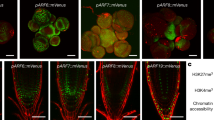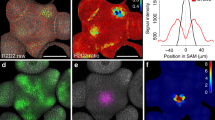Abstract
Cell specification in development requires robust gene-regulatory responses to transient signals. In plants, the small signalling molecule auxin has been implicated in diverse developmental processes1,2. Auxin promotes the degradation of AUXIN/INDOLE-3-ACETIC ACID (AUX/IAA) inhibitors that prevent AUXIN RESPONSE FACTOR (ARF) transcription factors from regulating their target genes1,3. However, the precise role of auxin in patterning has remained unclear, the view of auxin acting as a morphogen is controversial4,5 and the transcriptional control of the ARF genes themselves is barely explored6. Here, we demonstrate by experimental and computational analyses that the Arabidopsis ARF protein MONOPTEROS (MP) controls its own expression and the expression of its AUX/IAA inhibitor BODENLOS (BDL), with auxin acting as a threshold-specific trigger by promoting the degradation of the inhibitor. Our results suggest a general mechanism for how the transient accumulation of auxin activates self-sustaining or hysteretic feedback systems of interacting auxin-response proteins that, similarly to other genetic switches, result in unequivocal developmental responses.
This is a preview of subscription content, access via your institution
Access options
Subscribe to this journal
Receive 12 print issues and online access
$209.00 per year
only $17.42 per issue
Buy this article
- Purchase on Springer Link
- Instant access to full article PDF
Prices may be subject to local taxes which are calculated during checkout




Similar content being viewed by others
References
Lau, S., Jürgens, G. & De Smet, I. The evolving complexity of the auxin pathway. Plant Cell 20, 1738–1746 (2008).
Vanneste, S. & Friml, J. Auxin: a trigger for change in plant development. Cell 136, 1005–1016 (2009).
Chapman, E. J. & Estelle, M. Mechanism of auxin-regulated gene expression in plants. Annu. Rev. Genet. 43, 265–285 (2009).
Bhalerao, R. P. & Bennett, M. J. The case for morphogens in plants. Nat. Cell Biol. 5, 939–943 (2003).
Möller, B. & Weijers, D. Auxin control of embryo patterning. Cold Spring Harb. Perspect. Biol. 1, a001545 (2009).
Bowman, J. L. & Floyd, S. K. Patterning and polarity in seed plant shoots. Annu. Rev. Plant Biol. 59, 67–88 (2008).
Kauffman, S. Control circuits for determination and transdetermination: interpreting positional information in a binary epigenetic code. Ciba Found. Symp. 0, 201–221 (1975).
Meinhardt, H. Morphogenesis of lines and nets. Differentiation 6, 117–123 (1976).
Meinhardt, H. Models of Biological Pattern Formation (Academic, 1982).
Levine, M. & Davidson, E. H. Gene regulatory networks for development. Proc. Natl Acad. Sci. USA 102, 4936–4942 (2005).
Alon, U. Network motifs: theory and experimental approaches. Nat. Rev. Genet. 8, 450–461 (2007).
De Smet, I., Lau, S., Mayer, U. & Jürgens, G. Embryogenesis—the humble beginnings of plant life. Plant J. 61, 959–970 (2010).
Dharmasiri, N. et al. Plant development is regulated by a family of auxin receptor F box proteins. Dev. Cell 9, 109–119 (2005).
Weijers, D. et al. Developmental specificity of auxin response by pairs of ARF and Aux/IAA transcriptional regulators. EMBO J. 24, 1874–1885 (2005).
Hamann, T., Benková, E., Bäurle, I., Kientz, M. & Jürgens, G. The Arabidopsis BODENLOS gene encodes an auxin response protein inhibiting MONOPTEROS-mediated embryo patterning. Genes Dev. 16, 1610–1615 (2002).
Hamann, T., Mayer, U. & Jürgens, G. The auxin-insensitive bodenlos mutation affects primary root formation and apical–basal patterning in the Arabidopsis embryo. Development 126, 1387–1395 (1999).
Berleth, T. & Jürgens, G. The role of the monopteros gene in organising the basal body region of the Arabidopsis embryo. Development 118, 575–587 (1993).
Schlereth, A. et al. MONOPTEROS controls embryonic root initiation by regulating a mobile transcription factor. Nature 464, 913–916 (2010).
Weijers, D. et al. Auxin triggers transient local signalling for cell specification in Arabidopsis embryogenesis. Dev. Cell 10, 265–270 (2006).
Sheen, J. Signal transduction in maize and Arabidopsis mesophyll protoplasts. Plant Physiol. 127, 1466–1475 (2001).
Abel, S., Nguyen, M. D. & Theologis, A. The PS-IAA4/5-like family of early auxin-inducible mRNAs in Arabidopsis thaliana. J. Mol. Biol. 251, 533–549 (1995).
Tian, Q., Uhlir, N. J. & Reed, J. W. Arabidopsis SHY2/IAA3 inhibits auxin-regulated gene expression. Plant Cell 14, 301–319 (2002).
Ulmasov, T., Hagen, G. & Guilfoyle, T. J. ARF1, a transcription factor that binds to auxin response elements. Science 276, 1865–1868 (1997).
Ulmasov, T., Hagen, G. & Guilfoyle, T. J. Dimerization and DNA binding of auxin response factors. Plant J. 19, 309–319 (1999).
Ulmasov, T., Murfett, J., Hagen, G. & Guilfoyle, T. J. Aux/IAA proteins repress expression of reporter genes containing natural and highly active synthetic auxin response elements. Plant Cell 9, 1963–1971 (1997).
Friml, J. et al. Efflux-dependent auxin gradients establish the apical–basal axis of Arabidopsis. Nature 426, 147–153 (2003).
Harmer, S. L. The circadian system in higher plants. Annu. Rev. Plant Biol. 60, 357–377 (2009).
Hubbard, K. E., Robertson, F. C., Dalchau, N. & Webb, A. A. Systems analyses of circadian networks. Mol. Biosyst. 5, 1502–1511 (2009).
Cole, M. F. & Young, R. A. Mapping key features of transcriptional regulatory circuitry in embryonic stem cells. Cold Spring Harb. Symp. Quant. Biol. 73, 183–193 (2008).
Mayer, U., Büttner, G. & Jürgens, G. Apical–basal pattern formation in the Arabidopsis embryo: studies on the role of the gnom gene. Development 117, 149–162 (1993).
De Smet, I. et al. Bimodular auxin response controls organogenesis in Arabidopsis. Proc. Natl Acad. Sci. USA 107, 2705–2710 (2010).
Schütze, K., Harter, K. & Chaban, C. Bimolecular fluorescence complementation (BiFC) to study protein–protein interactions in living plant cells. Methods Mol. Biol. 479, 189–202 (2009).
Calderon-Villalobos, L. I. et al. LucTrap vectors are tools to generate luciferase fusions for the quantification of transcript and protein abundance in vivo. Plant Physiol. 141, 3–14 (2006).
Schwechheimer, C., Smith, C. & Bevan, M. W. The activities of acidic and glutamine-rich transcriptional activation domains in plant cells: design of modular transcription factors for high-level expression. Plant Mol. Biol. 36, 195–204 (1998).
Takada, S. & Jürgens, G. Transcriptional regulation of epidermal cell fate in the Arabidopsis embryo. Development 134, 1141–1150 (2007).
Clough, S. J. & Bent, A. F. Floral dip: a simplified method for Agrobacterium-mediated transformation of Arabidopsis thaliana. Plant J. 16, 735–743 (1998).
Sauer, M. & Friml, J. In vitro culture of Arabidopsis embryos. Methods Mol. Biol. 427, 71–76 (2008).
Acknowledgements
We thank C. Brancato for protoplast transfections, R. Kancheva and E. Özdemir for help with plant work, M. Kientz for help with RNA in situ hybridizations, and D. Weijers and M. Bayer for critical reading of the manuscript. This work was supported by the Max Planck Society, a grant from the Deutsche Forschungsgemeinschaft to G.J. (SFB 446) and long-term postdoctoral fellowships to I.D.S. from the European Molecular Biology Organization (ALTF 108-2006) and the Marie Curie Intra-European Fellowship Scheme (FP6 MEIF-CT-2007–041375).
Author information
Authors and Affiliations
Contributions
S.L. and G.J. designed the project, S.L., I.D.S., H.M. and M.K. carried out the research, and S.L., I.D.S., H.M. and G.J. wrote the manuscript.
Corresponding author
Ethics declarations
Competing interests
The authors declare no competing financial interests.
Supplementary information
Supplementary Information
Supplementary Information (PDF 684 kb)
Rights and permissions
About this article
Cite this article
Lau, S., Smet, I., Kolb, M. et al. Auxin triggers a genetic switch. Nat Cell Biol 13, 611–615 (2011). https://doi.org/10.1038/ncb2212
Received:
Accepted:
Published:
Issue Date:
DOI: https://doi.org/10.1038/ncb2212
This article is cited by
-
Specification of leaf dorsiventrality via a prepatterned binary readout of a uniform auxin input
Nature Plants (2022)
-
Control of vein-forming, striped gene expression by auxin signaling
BMC Biology (2021)
-
Genetic insights into the regulatory pathways for continuous flowering in a unique orchid Arundina graminifolia
BMC Plant Biology (2021)
-
Genome-wide identification of auxin response factors (ARFs) in three different species of Arachis
Plant Biotechnology Reports (2021)
-
Genome-wide analysis of lncRNA and mRNA expression and endogenous hormone regulation during tension wood formation in Catalpa bungei
BMC Genomics (2020)



